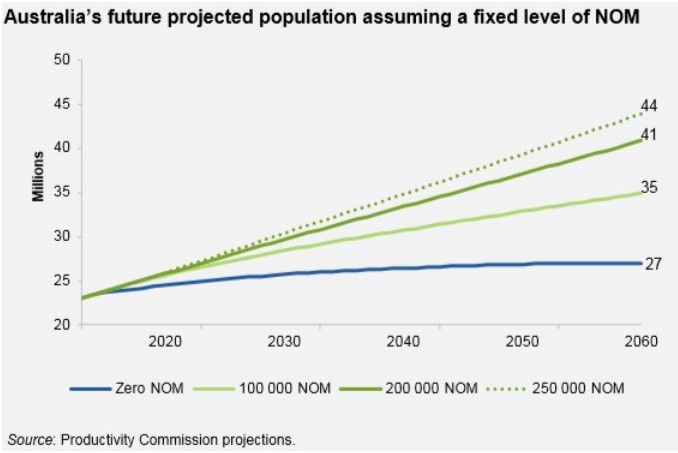Last week, I questioned why the Productivity Commission’s (PC) latest report, entitled Shifting the Dial: 5 year productivity review, failed to address Australia’s immigration settings despite explicitly acknowledging that:
- congestion costs are soaring across the major cities as rapid population growth overwhelms existing infrastructure; and
- the cost of expanding infrastructure has become prohibitive due to ‘dis-economies of scale’, such as land buybacks and tunneling, which means that second-best measures like congestion pricing are required to meet the ever-growing demand.
The Grattan Institute’s Growth Program director, Jim Minifie, briefly noted similar concerns in The Conversation last week:
…the report gives short shrift to population growth. Governments are racing to keep pace with population growth in Melbourne and Sydney in particular, yet the report does not consider how population contributes to congestion, how it dilutes the value of natural resource rents, and how the challenges it creates for governments make it more difficult for them to deliver reforms that would boost productivity.
Over the weekend, Fairfax’s Crispin Hull delivered the most damning assessment yet of the PC’s (deliberate?) omission:
This week’s Productivity Commission report… delves into seemingly intractable problems of congestion, urban sprawl, development entanglements, renewing and adding to infrastructure, and so on, suggesting all sorts of better processes, incentives and disincentives.
Don’t get me wrong. The suggestions are well-thought-out and try to weed out the worst sort of rent-seeking and political machinations. But they are all curative of problems without mentioning one of the main underlying causes: rapid population growth.
It is astonishing that one of the most-respected economic institutions in the country can do a five-year review of productivity without some detailed discussion of population policy and what effect the ramping-up of immigration since the Howard years, including Kevin Rudd’s “big Australia”, has had and will have in the future…
Australia needs to build the equivalent of a city like Canberra every year to accommodate this growth.
So what’s the point of delivering an immensely detailed five-year review if all its recommendations are compromised by a population non-policy, under which, every year, the government plucks a figure from the air with precious little concern about long-term economic effects.
It is completely negligent for those such as the Productivity Commission, nearly every federal and state politician, and a raft of greedy special-interest lobbyists to couch the issue as “What do we do to accommodate this population growth?” instead of “How can we reduce the population growth?”.
For example, the commission says we should impose road-use charges, the equivalent of a congestion tax, to deal with traffic congestion and its huge economic costs. And state governments should build more expensive roads in a futile attempt to catch up. This Band-Aid, treat-the-symptoms approach is not just negligent, it is outright dangerous.
The danger lies in opportunist political figures like Pauline Hanson linking the ills of overpopulation (congestion, hospital waiting times, housing prices, stalled wages growth and the like) to Muslim immigration. The more that people who profit from high population growth and do not suffer the consequences (business, lobbyists and the politicians they fund) blithely ignore the infrastructure and other stresses it causes, the more chances there will be for opportunists…
In Australia, we should celebrate the wonderful things immigration has done for our economy and society in the past. But we should not put that in jeopardy with too much immigration now…
The important thing now is for the main parties to forget the wishes of their donors and concentrate on the wishes of voters – before One Nation, the Australian Conservatives and others exploit the discontent in an ugly way.
And key parts of the bureaucracy should not take high population growth as a given and advise only on how to cope with it, but also advise on its downside and how it can be checked.
Brilliantly said. The PC’s own Migrant Intake Australia report, released last year, showed that Australia’s population would reach just 27 million mid-century under zero net overseas migration (NOM) versus more than 40 million under current mass immigration settings:

So that’s a difference in population of at least 13 million caused purely by NOM, which will have a massive impact on congestion, housing, infrastructure needs, Australia’s environment, the trade and current account deficits, as well as overall livability (especially in the major cities).
The PC should have, at a minimum, added as an explicit recommendation for the Government to review Australia’s ‘Big Australia’ immigration settings as well as the development of a national population policy that takes into account these negative externalities.
After all, how can a report seeking to improve Australians’ living standards be complete without addressing the main demand-driver – mass immigration – that is causing many of the pressures in the first place?

